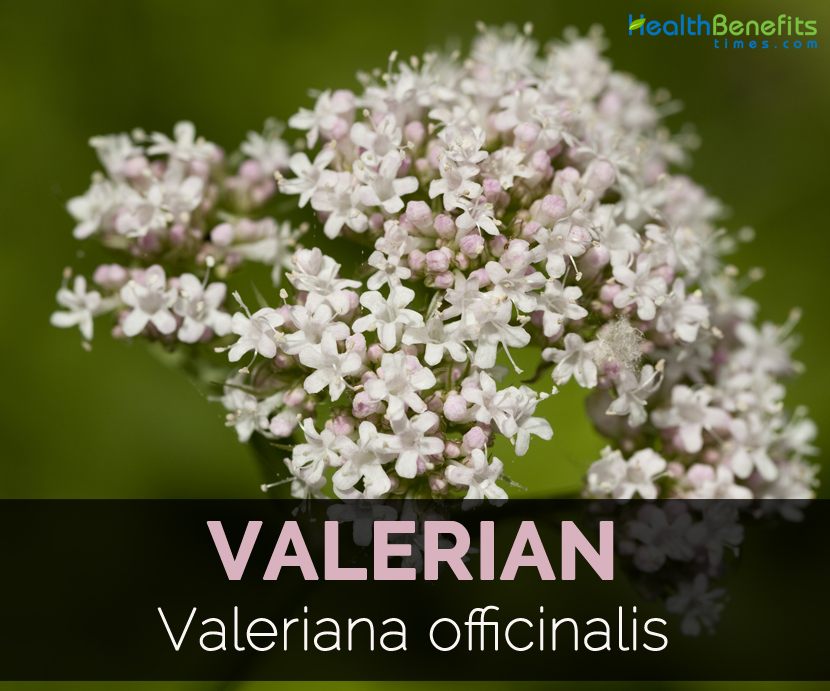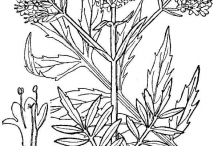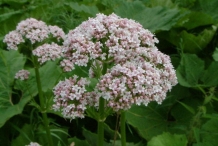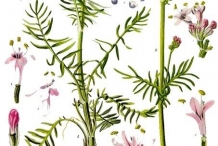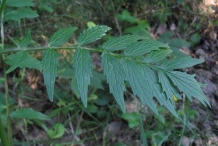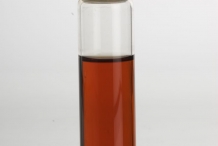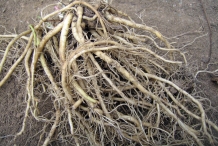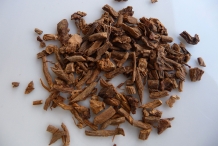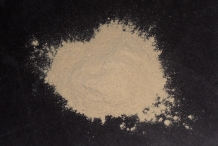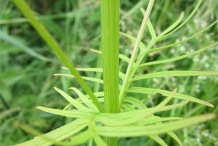In herbal medicine and pharmacology, Valerian is the name of herb or dietary supplement which is prepared from plant roots. A crude extract of root could also be found in the form of capsules. It provides anxiolytic and sedative effects. Yellowish-green to brownish-yellow oil is a chief constituent of Valerian that is found in dried root which varies from 0.5 to 2.0%. The active ingredients in volatile oils are intensely pungent which is similar to well matured cheese.
Valerian acts as a mild tranquilizer in patients having emotional stress. It functions as an effective sleep aid and gentle relaxant. It has been used to treat anxiety, insomnia, stomach cramps and nervous restlessness.
History
Valerian is a European plant which is grown in wet places as well as in dry pastures. The plant bears flower in June and July. Assorted varieties are grown in America and are used. Roots are an officinal part. Root has camphoraceous, warm, acrid, bitter and nauseous taste. Odor is not considerable. Roots contain albumen, starch, balsamic resin, yellow extractive matter, valerianate of potassa, mucilage, phosphate of lime and silica and malates of potassa and lime.
Plant
It is a perennial and herbaceous plant which measures 50 to 100 cm in height. It is sparingly branched. The plant has light green central stem which is terete, stout, finely ribbed, pubescent and glabrous. An interior stem is hollow. Leaves are odd to pinnate having 4 to 9 pairs of sessile leaflets. Leaves measures about 8 inches long. Leaflets are linear to lanceolate to lanceolate to oblong in shape with smooth and sparingly dentate margins. An upper surface of leaflet is glabrous, medium and dark green whereas the lower surface is glabrous, slightly hairy and is pale. Lower and basal leaves possess longer petioles in comparison to upper leaves. Sometimes latter are sessile. The panicles of pedicles and peduncles are glabrous, pubescent and light green. Flowers are trumpet shaped, light pink or white measuring 4 mm long. Corolla has five spreading lobes and short green calyx have 3 stamens, 5 teeth and pistil with a style. Flowers are fragrant and blooms during summer for a month or two. Flowers are then replaced by achenes of 4 mm long, lanceoloid shape and slightly flattened with feathery hairs. It has rhizomatous and fibrous root system. Sometimes rhizomes produce colonies of clonal plants.
Flower and Fruit
Flowers are pink to white, androgynous which are in panicled cymes. Calyx is made up of 10 revolute tips. Corolla is in funnel shaped having five sectioned margin. Tube has a bump at a base. An ovary has three chambers and is inferior. There are three stamens. Fruit is indehiscent, ovate to oblong in shape, yellow and have 10 rayed tuft of white hair.
Leaves, stem and root
Plant grows about 500 to 100 cm high with a short and cylindrical rhizome having finger length and bushy round roots. Stem is unbranched and erect. Leaves are odd to pinnate having 11 to 23 lanceolate and indented-dentate leaflets. Upper ones are sessile and clasping with white sheath and lower ones are petiolate.
Health Benefits of Valerian
Valerian is native to Europe which grows wild in grasslands. It is used to decorate garden. Stems possess dark leaves. Roots are made into fine powder, pressed into juice and used for therapeutic purposes. The extracts are also available in the form of tea, tablets and capsules. It provides various health benefits such as promote calm and aid sleep. It has been used as a cure for insomnia as well as nerve conditions such as restlessness and anxiety.
- Acts as anticonvulsant
The extracts of Valerian featured anticonvulsant properties. The study was conducted to examine anticonvulsant properties of valerian extracts and valerenic acid and for determining whether the preparations of Valerian interact with anti-epileptic drugs activity. An adult zebrafish as an animal model was studied to find out the potential of antiepileptic drugs. In adult zebrafish, valerian and valerenic acid promote latency to PTZ induced seizure in a concentration dependent manner having more potent ethanolic extract. The extracts of ethanolic valenian potentiate antiepileptic effects of both clonazepam and phenytoin. Valerenic acid and valerian preparations interacted co-operatively having minimal concentration of clonazepam to promote latency to convulsions and upgrade survival. The results shows new therapeutic alternatives for epileptic patients. (1)
- Treatment for Parkinson’s disease
Parkinson’s disease is a neurodegenerative disorders which has become a common problem. The experiments reported cytoprotective effects of Valerian extracts for Parkinson’s disease. Moreover, considering Parkinson’s disease as a result of mitochondrial metabolic imbalance and oxidative stress, genomic approach for evaluation of possible underlying mechanisms of plant extract effect was added. The results brought new approach to Valerian extract and suggested that hesperidin and linarin have the ability to relieve oxidative stress effects during depletion of ATP because of its ability to bind SUR1. Additionally, vital role of valerenic acid and apigenin helps to prevent cortical hyperexcitation by activating neuronal cells from SN to release GABA on brain stem. Under oxidative stress, hyperexcitability and asphyxia, Valerina triggers various mechanisms for providing protection to neuronal cells. (2)
- Cardiovascular health
Valerian is a flowering plant which is renowned for its essential oils and iridoid compounds such as sesquiterpenes, monoterpenes, alkaloids, flavonoids, lignanoids and amino acids. Valerian displayed various biological activities such as lowering blood pressure, heart rate, antiarrhythmia, antimyocardial ischemia reperfusion injury and regulation of blood lipid levels. The review targets on chemical constituents as well as cardiovascular activities of Valerian. Valerian contains various bioactivities which have been discussed by its complex and various active ingredients. Though the effects of Valerian affected cardiovascular system, still further investigation is required for its mechanism of action. (3)
- Cure for insomnia
Insomnia has affected about one third of the population. It results in increasing rate of social disability, health care use and abseentism. The root extracts of Valerian are used to promote sleep and the sleep quality. The trials showed the use of Valerian to improve quality of sleep. The evidence shows that Valerian might promote quality of sleep without showing side effects. Further studies should show range of doses of standardized preparations of Valerian and involve standard measures of safety and sleep quality. Future studies of Valerian should be granted for high priority as insomnia is given high predominance worldwide. (4)
- Helpful for depression
Neuroimmune facts are the contributors of depression. Beside its therapeutic effects, Valerian showed anti-inflammatory properties. The study showed the effects of Valerian’s hydro alcoholic extract on depression in ovalbumin sensitized rats. Results also supported traditional belief on the beneficial effect of Valerian on nervous system. Future studies are still needed to determine protective effect of Valerian. (5)
- Treatment for anxiety
Valerian root promotes amount of chemical known as gamma aminobutyric acid in brain. GABA assists in regulation of nerve cells and calms anxiety. Valerian root extract has valerenol and valerenic acid which acts as anti-anxiety agents. Valerian root possess anti-anxiety effects like prescription drugs without any serious side effects.
- Reduce blood pressure
Valerian root helps to calm body as well as mind. It also lowers blood pressure by improving heart health. The active components found in Valerian root are effective for anxiety and stress management which helps to regulate blood pressure. High blood pressure increases the chances of getting stroke and heart attack. The supplements of Valerian root reduces blood pressure naturally and normalizes at healthy level that have positive impact on heart health.
- Lower menstrual cramps
Valerian root has relaxing properties which provides relief from menstrual cramps. It lowers the severity as well as discomfort of menstrual cramps that has become common for women who suffer from PMS. Being a natural antispasmodic and sedative, it suppresses muscle spasms and relaxes muscles. Valerian root helps to calm severe uterine muscle contractions which cause terrible pain in women that experience during menstruation.
- Reduce stress
Valerian root helps to lower anxiety and promotes length and quality of sleep with regular management of stress. Chronic stress makes feel anxiety which makes feel more stressed. With an improvement in GABA levels, it relaxes both body as well as mind. Valerian root lowers stress and improves quality of life. According to research, valerian root helps to restrain both psychological and physical stress.
Traditional uses
- It is useful for excitability, hysterical states, migraine, hypochondriasis, insomnia, cramps, migraine, rheumatic pains, intestinal colic, nervous excitability and dysmenorrhea.
- It provide mental relaxation and as an aid for sleep.
- Valerian provides relief from nervous tension.
- Valerian is helpful for sleeping disorders, restlessness, mental strain, nervous conditions, excitability, lack of concentration, neurasthenia, headache, stress, nervous cardiopathy, hysteria, epilepsy, pregnancy, menstrual states of agitation, neuralgia, menopause, colic, nervous stomach cramps, states of anxiety and uterine spasticity.
- As a sleep aid, use 400-900 mg of extracts 30 minutes before bed time.
- For restlessness, use 220 mg extract three times regularly.
- It is used as an aid for insomnia.
- Valerian is used to treat anxiety disorders.
- It helps to lower blood pressure.
- Apply it externally for ulcers, eczema and minor injuries.
- In Europe, it is used for abdominal cramps caused due to nervousness, menstrual agitation and uterine cramps.
- It provides relief from dysmenorrhea, rheumatic pain and migraine.
- Apply it topically for muscle tensions and cramps.
- Valerian is also a cure for headaches.
- Ancient Greeks use it to treat flatulence, nausea, insomnia and urinary tract disorders.
Precautions
- Avoid excessive consumption of alcohol while having treatment with valerian root preparations.
- People who are sensitivity to valerian should not use the root preparations of valerian.
- Not recommended to use by pregnant women and nursing mothers.
- If used excessively, it causes mental excitement, headaches, giddiness, visual illusions, spasmodic movements, agitation, stomachache, mental dullness, apathy, mild depression and restlessness.
- Valerian might cause allergic reactions such as difficulty in breathing, hives and skin rash. If experienced such allergic reactions then seek for medical advice.
- It should not be used with other depressants such as barbiturates, benzodiazepines, ethanol, kava, opiates or antihistamine drugs.
How to Eat
- It is added to soups and stews.
- Essential oil extracted from Valerian roots and leaves are used to add flavor of baked goods and ice cream.
Other Facts
- Leaves are pinnate which is covered in prickles and is arranged in form of rosette.
- Flowers have both types of reproductive organs.
- Blooming occurs from June to August.
- Flowers attract flies, bees and beetles which assist in pollination of plant.
- The propagation takes place by seed and division of root and rhizome.
References:
https://www.itis.gov/servlet/SingleRpt/SingleRpt?search_topic=TSN&search_value=35363#null
http://www.pfaf.org/User/Plant.aspx?LatinName=Valeriana+officinalis
http://www.floracatalana.net/valeriana-officinalis-l-
https://draxe.com/valerian-root/
Comments
| Valerian Quick Facts | |
|---|---|
| Name: | Valerian |
| Scientific Name: | Valeriana officinalis |
| Origin | Plants are found in temperate regions of Asia and Europe. It is cultivated in England, central Europe, Japan, France, eastern Europe, U.S. and Japan. |
| Colors | Yellow |
| Shapes | Ovate to oblong, indehiscent, 4 mm long |
| Health benefits | Acts as anticonvulsant, Treatment for Parkinson's disease, Cardiovascular health, Cure for insomnia, Helpful for depression |
| Name | Valerian |
|---|---|
| Scientific Name | Valeriana officinalis |
| Native | Plants are found in temperate regions of Asia and Europe. It is cultivated in England, central Europe, Japan, France, eastern Europe, U.S. and Japan. |
| Common/English Name | Ail-Heal, Setwall, Amantilla, Setewale, Heliotrope, Capon’s Tail, Vandal Root, Valerian Root, NuVeg Valerian Root, Herbal Sure Valerian Root, Valerian Root Alcohol Free, Valerian Root Power, Valerian Power Time Release, Standardized Valerian, Nature’s Root Nighttime, Natural Herbal, Valerian Root, Quanterra Sleep,Garden valerian, Indian valerian, Pacific valerian, Mexican valerian |
| Name in Other Languages | German: Echter Baldrian, Echter Arznei-Baldrian, Baldrian ; English: Common valerian, Garden heliotrope, Garden valerian, Garden-heliotrope, Valerian, European valerian, Allheal; Dutch: Echte valerian, Baldrian, Laege baldrian; French: valã©riane; German: Baldrian, Baldrianwurzel, Gebräuchlicher Baldrian; Greek: valeriána (βαλεριάνα); Italian: Baldriana, Valeriana, amantilla, erva gatta, valeriana, Valeriana comune ; Portuguese: Valeriana; Spanish: Valeriana; Catalan: Herba dels gats, Herba gatera, Valedriana, valeriana; Chinese: Kuān yè xié cǎo (宽叶缬草), Guǎngzhōu bá dì má (广州拔地麻), Bá dì suàn (拔地蒜), Ōu xié cǎo (欧缬草), Máo jié xié cǎo (毛节缬草), Xié cǎo (缬草); Finnish: Rohtovirmajuuri; French: Valériane de grande taille, Valériane des collines, Valériane officinale, Valériane officinale, Valériane des collines; Japanese: kanakoso, kesso; Polish: Walerian; Romanian: odolean, valeriană; Spanish: valeriana; Swedish: läkevänderot, Vänderot; Welsh: triaglog; Occitan: Pauta de chat, Valeriano, Valeriana; |
| Plant Size | 50 to 100 cm high |
| Stem | Erect, unbranched |
| Leaf | Pinnate, opposite |
| Flowering Season | Summer |
| Flower | Pink to white, 4 mm (3/16 inches) long |
| Fruit shape & size | Ovate to oblong, indehiscent, 4 mm long |
| Fruit color | Yellow |
| Plant parts used | Rhizome, root |
| Seed | Oblong |


